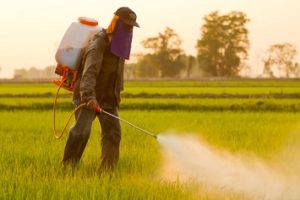The EPA has issued several documents in anticipation of amending provisions of the Obama administration’s agricultural Worker Protection Standard ((WPS), November 2, 2015, FR) and Certification of Pesticide Applicators Rule (January 4, 2017, FR). Three requirements of the WPS—minimum age, designated representative, and application exclusion zones—are targeted for possible amendment. The minimum age requirement in the Certification of Pesticide Applicators Rule would also be amended. Both rules revised existing programs.

2015 WPS
EPA’s stated intent of the 2015 WPS is to reduce occupational pesticide exposure and incidents of related illness among agricultural workers and pesticide handlers and to protect bystanders and others from exposure to agricultural pesticide use. Agricultural employers and handler employers were required to comply with most of the new requirements by January 2, 2017.
The goal of the Certification of Pesticide Applicators Rule is to ensure that federal certification program standards adequately protect applicators, the public, and the environment from risks associated with use of restricted use pesticides.
According to the Agency, the proposed changes to the WPS and the applicator rule are based on feedback it received from stakeholders after soliciting comments on actions it should take to implement President Donald Trump’s Executive Order, Enforcing the Regulatory Reform Agenda (March 1, 2017, FR).
Three Provisions
In a notice, the EPA states that it intends to publish a proposal in 2018 to solicit public input on revising the following WPS requirements:
- Minimum age. The 2015 WPS established a minimum age of 18 years for pesticide handlers and for early-entry workers, with an exemption for owners of agricultural establishments and their immediate family members. In a separate notice (December 19, 2017, FR), the Agency also announced that it has initiated rulemaking to revise the minimum age requirements in the Certification of Pesticide Applicators Rule.
- Designated representative. The 2015 WPS required agricultural employers to provide pesticide application information and safety data sheets to a designated representative of a worker or handler under certain circumstances. This requirement is in addition to the requirement for agricultural employers to provide that information to medical personnel, workers, or handlers requesting it.
- Application exclusion zones (AEZs). For outdoor production on farms, nurseries, and forests, the 2015 WPS established AEZ requirements to reduce the number of incidents where workers or other persons are exposed to pesticides during agricultural pesticide applications. The 2015 WPS requires agricultural employers to keep workers and other persons out of certain areas around the pesticide application equipment (i.e., AEZs) during ongoing pesticide applications, in addition to continuing the 1992 WPS requirement to keep workers and other persons out of the treated area. The 2015 WPS also requires pesticide applicators (handlers) to suspend a pesticide application if workers or other persons are in the AEZ.
Compliance Dates
In the WPS notice, the EPA states that the compliance dates in the revised WPS remain in effect and that the Agency does not intend to extend them. Compliance with most of the revised WPS requirements was required beginning January 2, 2017. Starting January 2, 2018, compliance will be required for two additional requirements—the requirement that the pesticide safety information display poster must include revised content and the requirement that pesticide handlers (applicators) will have to temporarily suspend applications if workers or other persons enter the AEZ during pesticide applications.
Also in the December 19, 2017, FR notice, the Agency announced that the implementation dates of the final Certification of Pesticide Applicators Rule for certifying authorities to submit revised certification plans and for EPA to act on those plans remain in effect.
“Therefore, if a certifying authority submits its modified certification plan by March 4, 2020, the existing approved certification plan remains in effect until EPA has approved or rejected the modified plan or March 4, 2022, whichever is earlier,” says the Agency.
